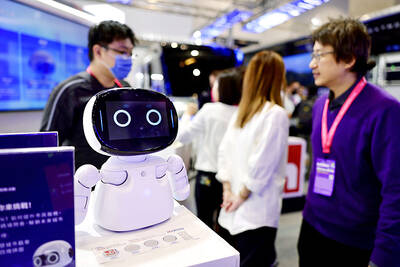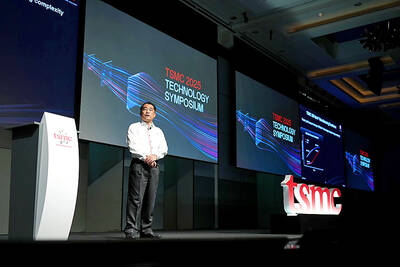Japanese carrier All Nippon Airways (ANA) said yesterday that it had ordered up to 25 of Japan's first domestically developed jet airplane from Mitsubishi Heavy Industries Ltd.
Japan's second-largest carrier decided at a board meeting yesterday to introduce the Mitsubishi Regional Jet (MRJ) into its fleet if the project goes ahead, it said in a statement.
It said it had placed a "firm order" for 15 of the planes and taken an option for a further 10, becoming the first customer for the aircraft.
No price was given. Mitsubishi said in October when it began seeking orders for the jet that the cost would be about ?3 billion to ?4 billion (US$30 million to US$40 million) each.
ANA chief executive Mineo Yamamoto said the order was "part of our drive to equip our fleet with the safest, most fuel efficient, environmentally friendly and passenger friendly aircraft available.
"The MRJ will play an important role in our strategy going forward," he said in a statement.
Mitsubishi Heavy is expected to confirm in the next few days that it is pushing ahead toward a commercial launch of the jet, which it says would be the most quiet, light and fuel-efficient model in its class.
The Mitsubishi jet project, which enjoys state support, would compete with small aircraft produced by Canada's Bombardier and Brazil's Embraer, as well as jets designed by Russian and Chinese firms. It would be the first commercial passenger aircraft in four decades -- and the first jet airplane -- to be developed in Japan.
Japan has in the past developed a turboprop plane, the YS-11, which was the only Japanese airliner built since World War II. It made its debut flight in 1962 and production ended in 1974.
The Mitsubishi plane would have 70 to 90 seats and be equipped with the new energy-saving "geared turbofan" engine designed by US-based Pratt & Whitney.
It said that if airlines show enough interest, the MRJ could enter commercial service by 2013.
If the project goes ahead, the Swedish aviation group Saab may get the maintanance contract.
"We are currently considering various options while moving toward a business alliance with Saab on maintenance and repairs," a Mitsubishi spokeswoman said.
She said that Saab may handle the maintenance work in Europe, the US and beyond.
The Yomiuri Shimbun reported yesterday that Mitsubishi was aiming to reach a final agreement with Saab as soon as next month.
Toyota Motor Corp said this month it was considering giving its financial backing to the venture.

DEMOGRAPHICS: Robotics is the most promising answer to looming labor woes, the long-term care system and national contingency response, an official said Taiwan is to launch a five-year plan to boost the robotics industry in a bid to address labor shortages stemming from a declining and aging population, the Executive Yuan said yesterday. The government approved the initiative, dubbed the Smart Robotics Industry Promotion Plan, via executive order, senior officials told a post-Cabinet meeting news conference in Taipei. Taiwan’s population decline would strain the economy and the nation’s ability to care for vulnerable and elderly people, said Peter Hong (洪樂文), who heads the National Science and Technology Council’s (NSTC) Department of Engineering and Technologies. Projections show that the proportion of Taiwanese 65 or older would

Nvidia Corp yesterday unveiled its new high-speed interconnect technology, NVLink Fusion, with Taiwanese application-specific IC (ASIC) designers Alchip Technologies Ltd (世芯) and MediaTek Inc (聯發科) among the first to adopt the technology to help build semi-custom artificial intelligence (AI) infrastructure for hyperscalers. Nvidia has opened its technology to outside users, as hyperscalers and cloud service providers are building their own cost-effective AI chips, or accelerators, used in AI servers by leveraging ASIC firms’ designing capabilities to reduce their dependence on Nvidia. Previously, NVLink technology was only available for Nvidia’s own AI platform. “NVLink Fusion opens Nvidia’s AI platform and rich ecosystem for

Taiwan Semiconductor Manufacturing Co (TSMC, 台積電) yesterday said it is building nine new advanced wafer manufacturing and packaging factories this year, accelerating its expansion amid strong demand for high-performance computing (HPC) and artificial intelligence (AI) applications. The chipmaker built on average five factories per year from 2021 to last year and three from 2017 to 2020, TSMC vice president of advanced technology and mask engineering T.S. Chang (張宗生) said at the company’s annual technology symposium in Hsinchu City. “We are quickening our pace even faster in 2025. We plan to build nine new factories, including eight wafer fabrication plants and one advanced

‘WORLD’S LOSS’: Taiwan’s exclusion robs the world of the benefits it could get from one of the foremost practitioners of disease prevention and public health, Minister Chiu said Taiwan should be allowed to join the World Health Assembly (WHA) as an irreplaceable contributor to global health and disease prevention efforts, Minister of Foreign Affairs Lin Chia-lung (林佳龍) said yesterday. He made the comment at a news conference in Taipei, hours before a Taiwanese delegation was to depart for Geneva, Switzerland, seeking to meet with foreign representatives for a bilateral meeting on the sidelines of the WHA, the WHO’s annual decisionmaking meeting, which would be held from Monday next week to May 27. As of yesterday, Taiwan had yet to receive an invitation. Taiwan has much to offer to the international community’s